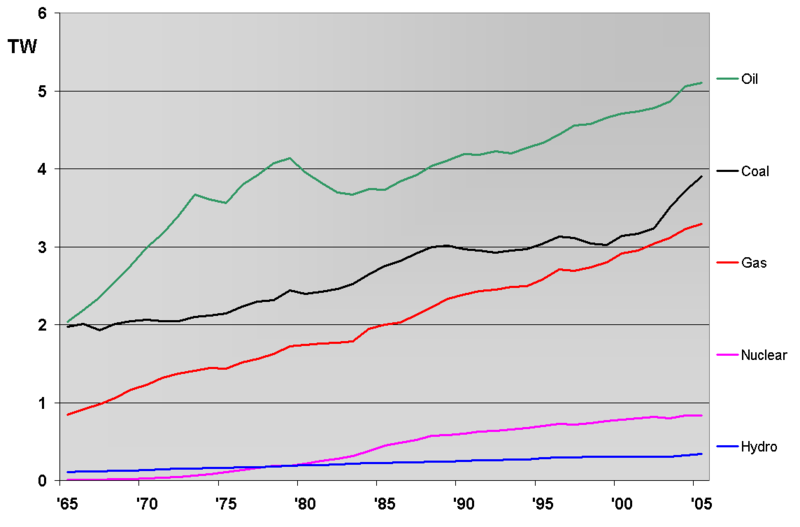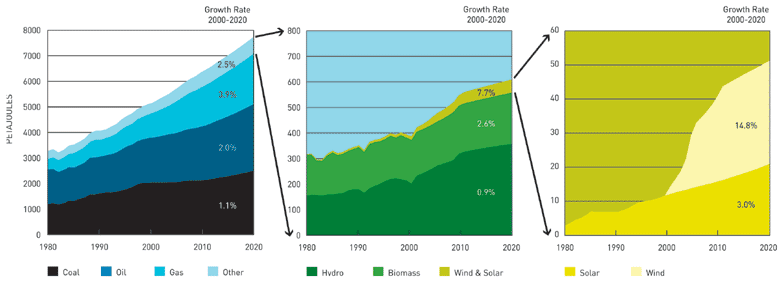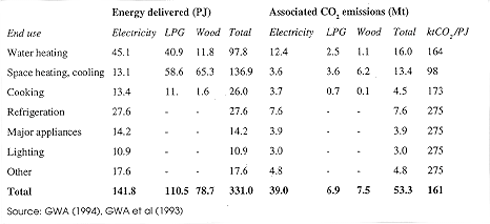World energy
resources and consumption
T o
make it easier to compare the numbers, this article uses SI units and
prefixes and measures energy rate (or power) in watts (W) and
amounts of energy in joules (J). The non-SI unit quad, equal
to 1.055 EJ (=1018 J) is sometimes used to report energy
usage.
o
make it easier to compare the numbers, this article uses SI units and
prefixes and measures energy rate (or power) in watts (W) and
amounts of energy in joules (J). The non-SI unit quad, equal
to 1.055 EJ (=1018 J) is sometimes used to report energy
usage.
In
2004, the worldwide energy consumption of the human race was
on average 15 TW (= 1.5 x 1013 W) with 86.5% from burning
fossil fuels. This is equivalent to 471,000 PJ (= 4.71 x 1020
J) per year.
The
remaining worldwide energy resources are large,
the
remaining fossil fuels totaling an estimated 400 ZJ (1 ZJ =
1021J)
the
available nuclear fuel such as uranium exceeding 2.5 YJ (1 YJ =
1024J).
Mostly
thanks to the Sun, the world also has a renewable usable energy flux
that exceeds 120 PW (8,000 times 2004 total usage), or 3.8
YJ/yr, dwarfing all non-renewable resources.
Using
1995 figures provided by the World Bank, in that year, the world's
energy consumption totaled 316 quadrillion BTUs.
A
BTU, or British Thermal Unit, is a standard measure of energy that
can be used regardless of the type of energy being produced.
For
example, there are 3,413 BTUs in a kilowatt hour of electricity.
A
barrel of oil contains 5.8 million BTUs.
B1b1_s1
AUSTRALIAS
ENERGY SUPPLY & USAGE
Developing
Australia's abundant low-cost energy resources is a key to our future
prosperity. Australia is the world's fourth largest producer, and
largest exporter, of coal. We supply 8 per cent of the world trade
for liquefied natural gas, and possess 40 per cent of the world's
low-cost uranium reserves. Our known oil reserves are significant,
but are projected to decline in the absence of new discoveries.
Australia has significant wind and solar resources, and limited large
hydro resources. Investment committed on energy projects under
development in Australia totaled $11.1 billion at April 2004 and a
further $38.8 billion in investment is under consideration (ABARE
2004).
Figure 1: Composition of Australian energy supply Total
Energy ‘Other' Energy Wind and Solar Energy
Renewable
energy is an essential part of Australia's low emissions energy mix
and is important to Australia’s energy security. It plays a
strong role in reducing Australia’s greenhouse gas emissions
and helping Australia stay on track to meet its Kyoto target and
beyond. Australian Government support for renewable energy assists
industry development, reduces barriers to the national electricity
market, and provides community access to renewable energy.


B1b1_s2
 o
make it easier to compare the numbers, this article uses SI units and
prefixes and measures energy rate (or power) in watts (W) and
amounts of energy in joules (J). The non-SI unit quad, equal
to 1.055 EJ (=1018 J) is sometimes used to report energy
usage.
o
make it easier to compare the numbers, this article uses SI units and
prefixes and measures energy rate (or power) in watts (W) and
amounts of energy in joules (J). The non-SI unit quad, equal
to 1.055 EJ (=1018 J) is sometimes used to report energy
usage.
